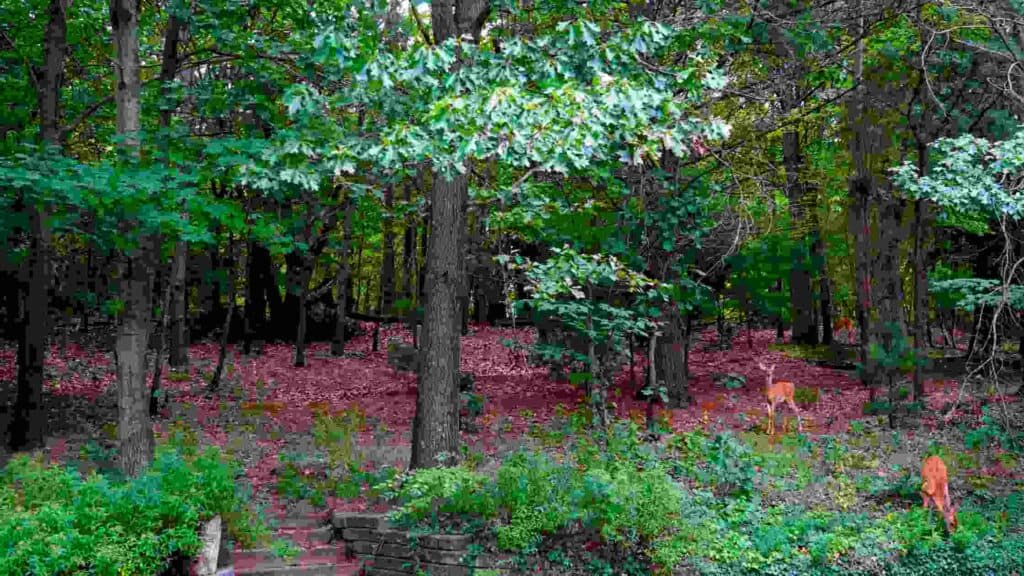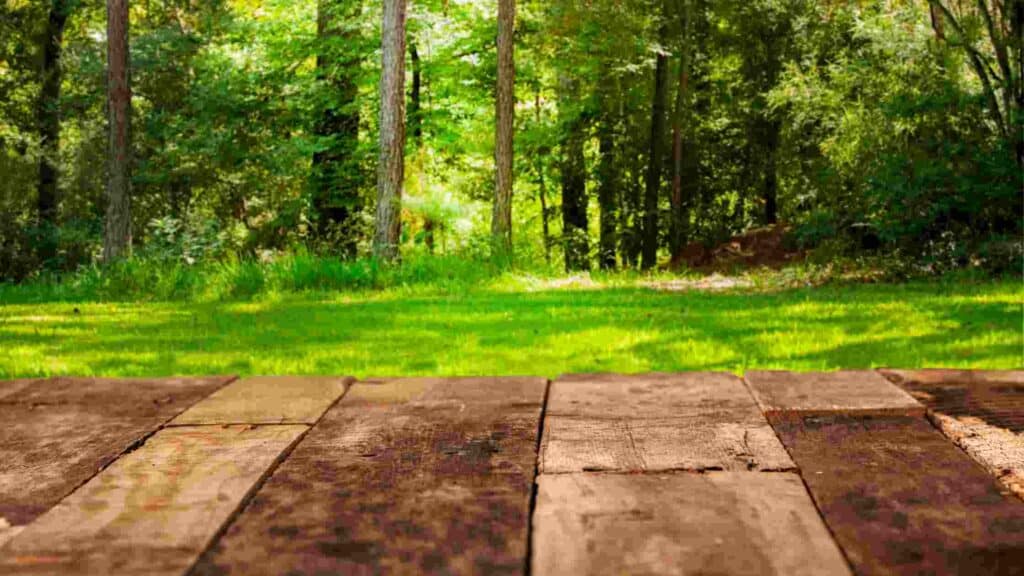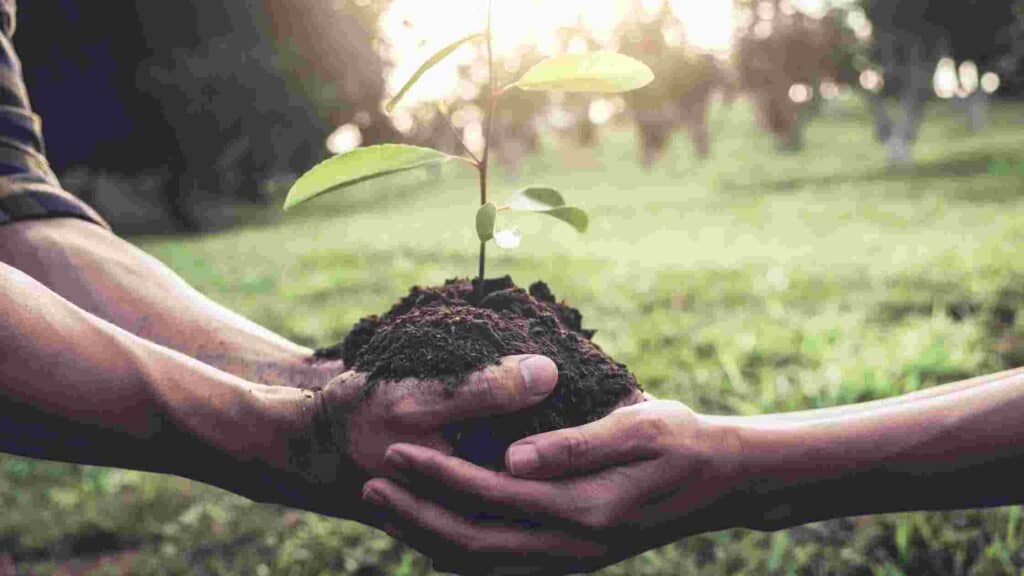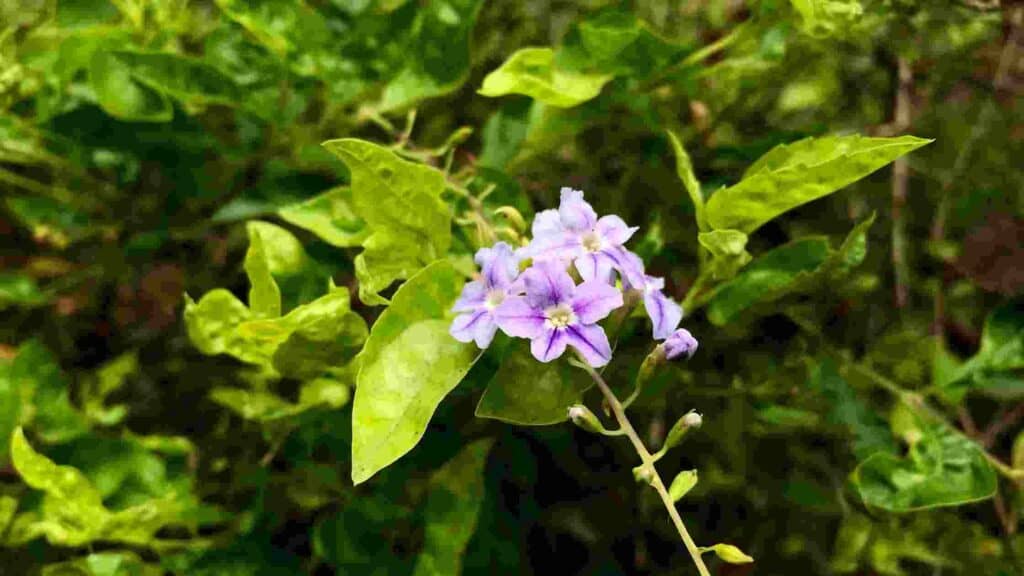Do you find solace in the serene embrace of a forest, where trees tower above, birds serenade, and the world seems to slow down? If you’ve ever wondered how to grow a forest in your backyard, you’re in for a captivating journey.
While turning your yard into a full-fledged forest overnight is a tall order, you can embark on an ecological adventure that promises remarkable results in the long run.
The key lies in embracing a holistic approach to forest gardening that will gradually transform your backyard into a lush woodland haven.
How To Grow A Forest In Your Backyard
Afforestation is the art of birthing a forest where none existed before, but it is indeed a process, one that involves careful planning and consideration.
Here are the steps to begin your journey toward transforming your backyard into a thriving forest:
1. Soil Testing – Laying The Foundation
Before you dive into transforming your backyard into a thriving forest, start with a crucial step: testing your soil (find out the best soil test kit).
This analysis will unveil essential information about your soil’s composition, setting the stage for successful tree planting.
Evaluate Soil Density
Compacted, hard soil can stifle tree roots and hinder growth. Your soil should allow water and essential minerals to flow naturally.
Check Alkalinity vs. Acidity
The pH level of your soil matters. Most tree species prefer neutral or slightly acidic soil. Knowing your soil’s pH will help you choose the right trees.
Macronutrient Considerations
Don’t forget about macronutrients like sulfur, magnesium, and calcium. These also play significant roles in soil health. You can even amend your soil with micronutrients like iron, copper, nickel, manganese, and boron.
Micronutrient Assessment
Test for vital micronutrients, particularly nitrogen, phosphorus, and potassium (the “NPK” trio). Identifying any deficiencies in these elements is crucial for initiating healthy forest growth.
Once you’ve pinpointed your soil’s major deficiencies, visit your local garden center or explore online options for the nutrients needed to amend your soil. This marks the beginning of the slow but steady process of revitalizing your soil to its prime health.
2. Right Trees For Planting A Forest In Your Backyard

To flourish, your forest-in-progress needs the right tree species. Begin your selection process by exploring the types of trees that naturally thrive in your area or nearby forests. Local conditions are often the best guide.
Regional Insights
Your choice should align with your specific region, taking into account factors like soil type, climate, and elevation. To make an informed decision, consider consulting your local master gardener extension office.
They can provide insights into which native plants and trees flourish naturally in your area, a valuable resource as you embark on your backyard forest journey.
Native Wisdom
Opt for native tree species that harmonize with your regional climate and soil composition. For instance, deciduous hardwoods thrive in loamy, sandy soil, while conifers are hardy and can handle heavier clay soils.
3. Planting Ratios – How To Make A Forest Garden
Now that you’re armed with the right trees, it’s time to consider planting ratios for your budding forest. The goal is to create optimal conditions for lush growth.
Forest Canopy
A dense canopy is key. It retains moisture in the soil around tree roots and prevents rapid evaporation of rainwater. This moisture promotes robust tree growth.
Sapling Strategy
Plant saplings or young trees, in a dense arrangement, approximately 4 saplings for every 30-55 square feet. This tight configuration will swiftly form a thick tree canopy, effectively blocking sunlight from reaching the ground.
Healthy Competition
The closely spaced trees will naturally vie for sunlight at the canopy level. This competition fosters accelerated growth, a vital factor in the rapid development of your backyard forest.
4. Embrace Natural Regeneration – How To Make A Small Forest
In your quest to create a backyard forest, don’t overlook the essential role of natural processes. Trees, in their seasonal shedding of needles or leaves, contribute to the forest’s cycle of life.
As these fallen needles and leaves accumulate on the forest floor, they become part of the detritus, decaying organic matter.
Microorganisms in the soil work their magic, breaking down this detritus into fertile humus. This humus, in turn, enriches the soil, enticing beneficial insects to join the ecosystem.
In this intricate balance between rain, trees, and soil bacteria, fallen leaves are recycled into essential nutrients.
These nutrients lay the foundation for the next generation of tree growth. The heartbeat of any forest lies in this process of decay and regeneration, a testament to the enduring vitality of nature.
5. Allow Nature To Unfold – How Long Does It Take To Grow A Forest?
The final step in your backyard forest journey demands a virtue that might be challenging: patience. Cultivating a forest means surrendering to the rhythms of nature and letting it work on its own timetable.
Remember this: according to estimations from forestry experts, in as little as 10 years, your backyard could transform into a woodland reminiscent of a century-old forest. The result will be an ecologically sustainable haven that requires minimal upkeep, right in your own backyard.
You may also be interested in checking out how to make your backyard warm.
Forests: Then And Now – Rediscovering Nature’s Bounty

In times long past, the Earth was draped in a verdant tapestry of forests, stretching as far as the eye could see. These forests, teeming with life, played a crucial role in sustaining humanity, providing lumber for our homes and ships.
Yet, the relentless demand for raw materials, coupled with the expansion of urban areas, led to a decline in the Earth’s forest cover.
Today, as we grapple with the consequences of this transformation, many of us yearn to rekindle the magic of forests, even on modest residential or urban plots. The challenge, however, is how to do so effectively.
Converting Your Backyard Into A Forest – A Green Metamorphosis
Transforming your backyard into a forest is not a simple task, for most backyards are synonymous with neatly manicured lawns.
Yet, it is precisely this challenge that makes the endeavor all the more meaningful, significant, and aesthetically pleasing.
Driven by concerns about biodiversity, land use, and sustainability, innovative solutions have emerged to expedite the regeneration of forest habitats on even the smallest of land parcels.
Some experts have cracked the code to accelerate forest growth tenfold, a remarkable feat in the world of forestry.
How Many Acres Does It Take To Make A Forest?
In essence, this means you can potentially turn your backyard into a century-old forest in just a decade, provided you have around 1000 square feet or slightly over 0.02 acres to spare.
To put it in perspective, the average backyard in the United States is approximately a quarter of an acre or 0.25 acres, well beyond the required space for a rapid forest transformation.
Why Forests Are Vital – Nature’s Treasures

Forests are not just collections of trees; they are ecosystems with life, playing invaluable roles in our world.
1. Combatting Climate Change
Trees, in their remarkable way, convert carbon dioxide into life-giving oxygen. Beyond that, forests are formidable allies in the fight against climate change.
They sequester excess carbon within the soil, reducing carbon levels in the atmosphere, which can otherwise contribute to global warming and ozone depletion.
2. Biodiversity
Forests are homes to countless animals, plant species, fungi, and insects found nowhere else on Earth. This rich tapestry of life works together to maintain the overall health of the forest ecosystem.
Some forest species offer medicinal benefits to humans, like goldenrod and nettle. Many berries, forest plants, and fungi also grace our tables as culinary delights.
3. Health And Well-being
The forest’s embrace has the power to soothe the soul and enhance our health. The Japanese practice of “forest bathing” encourages spending time among trees to connect with nature.
Scientific studies demonstrate that forest time can reduce stress, lower blood pressure, enhance overall well-being, and boost mood. It can also improve sleep quality and energy levels, and aid in healing from injuries or illnesses.
Having your private backyard forest is a gift to your family, especially for children who often spend more time indoors.
With a forest right outside their door, they can explore shrubs, trees, and wildlife while staying close to home, forging a deep connection with the natural world.
Recommended reading: How to make your backyard smell better?
4. Habitat For Local Wildlife
In an age marked by deforestation and urban expansion, wild animals often find themselves displaced from their natural homes.
By embarking on the journey to grow a forest in your backyard, you become a steward of nature, offering sustenance and vital shelter to local wildlife.
Nature’s Pantry
Your forest yields a bounty of seeds, nuts, and wild berries, ensuring a consistent food source for your newfound animal neighbors.
A Safe Refuge
Your burgeoning forest provides nesting spots, burrows, and hiding places for animals like squirrels, birds, and rabbits. It becomes a haven where they can thrive, sheltered from the challenges of an increasingly developed world.
However, it’s important to remember that where prey animals gather, predators often follow. Predators are a natural part of the ecosystem and play a vital role in maintaining balance.
Be prepared for the possibility of encountering creatures like foxes, coyotes, or snakes in your backyard.
Take necessary safety precautions, such as fencing in areas for pets and keeping a vigilant eye on children when they venture outdoors (check out: Can foxes climb fences?).
5. Landscape Enhancement – Green Beauty And Property Value
While perhaps not the most prominent benefit, growing a forest in your backyard can work wonders for your landscape, offering aesthetic appeal and potential property value increase.
A Flourishing Yard
Your backyard, once a barren canvas, will transform into a verdant masterpiece. Expect colorful flowers, lush greenery, the harmonious presence of wildlife, and soothing shade.
If you ever decide to sell your home and property, this newfound privacy and natural splendor will undoubtedly captivate the right buyer.
Privacy And Natural Beauty
Trees serve as a picturesque and natural privacy barrier, far more charming than hedges or fences. They create a serene backdrop, separating your space from your neighbors in a visually pleasing way.
Gardening Creativity
A backyard forest opens doors to gardening creativity. Envision captivating tree sculptures or a Fairy Garden nestled within this green haven, creating a touch of magic in your outdoor oasis.
Old Growth vs New Growth Forests – Nature’s Diversity
Forests, often resilient and tenacious, persist unless subjected to nature’s fury – wildfires, hurricanes, or human exploitation. In the forest realm, a fascinating contrast exists between old-growth and new-growth forests.
Old-Growth Elegance
These forests, standing for centuries, are sanctuaries for certain bird species like the wood thrush and cerulean warbler, as well as various wildlife. They are nature’s time capsules, showcasing the beauty of ancient trees.
The Emergence Of New Growth
New growth forests, a vibrant counterpart, have recently sprung forth or been cultivated.
Studies reveal their significance as vital habitats for creatures like hognose snakes, box turtles, and field sparrows. These early successional landscapes teem with vines, edible berries, and saplings, creating a thriving ecosystem.
In your pursuit of transforming your backyard into a forest, you will be nurturing a sanctuary that provides sustenance and refuge for specific wildlife and bird species.
This not only contributes to global biodiversity but also offers you the joy of witnessing a vibrant tapestry of life within your newfound forest realm.
Afforestation Progress – A Glimpse of Hope

As forests dwindled due to the relentless march of human settlements, roads, and agriculture, we witnessed the Earth’s once-lush expanses shrink.
However, even in this era of diminishing forests, there are tales of triumph and innovative methods for successful afforestation.
Sustainable Forestry In The United States
Remarkably, in certain U.S. regions like the Northeast, the number of trees per acre has risen over the past century.
Sustainable forestry practices have played a pivotal role in reforesting areas that were once ravaged by agriculture and lumbering.
The Permaculture Approach
Permaculture, a regenerative design and planting method, stands as a beacon of hope.
It doesn’t just create forests; it seamlessly integrates edible landscapes with burgeoning woodlands. This versatile approach adapts to diverse climates and regions, offering a holistic solution.
FAQs – How To Create A Forest In Your Backyard
1. How do I make a mini forest in my yard?
Create a mini forest in your yard by planting a variety of native trees and shrubs closely together to mimic a natural woodland setting.
2. How to plant a small forest?
Planting a small forest involves selecting diverse tree and shrub species, spacing them close together, and providing proper care and maintenance.
3. What is a micro forest?
A micro forest is a tiny, densely planted forest ecosystem, often featuring a mix of native trees, shrubs, and ground cover, designed to promote biodiversity and sustainability.
4. How to grow a forest in your backyard with trees?
To grow a forest in your backyard with trees, choose native species, plant them close together, provide adequate watering and maintenance, and consider the specific needs of each tree species.
5. What is a backyard forest garden?
A backyard forest garden is a designed space that combines elements of a forest ecosystem with cultivated plants, creating a sustainable and productive garden that mimics a natural forest.
Conclusion: How To Grow A Forest In Your Backyard
If you ever pondered how to transform your backyard into a flourishing forest, this journey is a testament to its feasibility.
By crafting an ecologically sustainable habitat, you lay the foundation for a biodiverse haven, where trees, plants, insects, fungi, and wildlife coexist harmoniously.
Today, roughly 31 percent of our planet remains forested. Consider the marvel that, with patience and dedication, you have the power to augment this percentage and revel in the proximity of a thriving forest right in your own backyard.
This endeavor is not just a green dream; it’s a tangible reality, a testament to the indomitable spirit of nature and human stewardship.
You might also find the following article helpful: How to make a backyard putting green.
